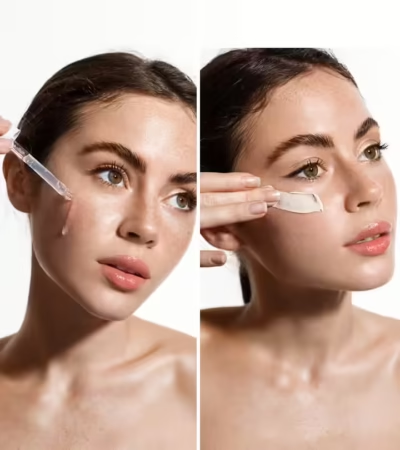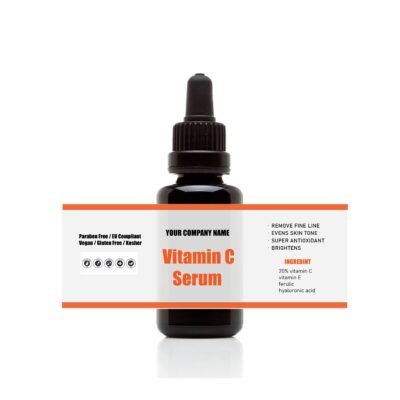Vitamin C Serum vs. Moisturizer:
Ingredient Evaluation, Pairing Guide, and Consumer Selection Strategy

In the skincare market, “vitamin C” has changed from a lab ingredient to a “must-have” for consumers. People use it for brightening, antioxidant effects, and collagen stimulation.
Shoppers often see “vitamin C serums” and “vitamin C moisturizers” on shelves. They may wonder what the difference is. How to choose? This article looks at these questions by examining ingredient science, market data, and what consumers want.
Vitamin C Serum vs. Moisturizer: Core Differences in “Function”
To understand their differences, start with the basic functions of serums and moisturizers.
Serums concentrate on delivering active ingredients with high efficacy. Their light texture is usually water-based or like lotion. They help higher amounts of active ingredients, such as 10%–20% vitamin C, absorb into the skin with speed.
Moisturizers focus on “hydration and barrier repair.” They have a thicker texture, like creams or emulsions. These products contain occlusives, such as squalane and shea butter.
They also have humectants, like hyaluronic acid derivatives. Together, they create a protective film. This film helps reduce moisture loss and strengthens the skin barrier. AAD research shows that moisturizers with ceramides and hyaluronic acid can cut water loss by 35%.
Vitamin C serums provide “deep benefits” like brightening, antioxidants, and anti-aging. Vitamin C moisturizers provide daily care. They hydrate and help maintain skin stability. They complement, not replace, each other.
Key Ingredient Pairings: The Synergy of Vitamin C with Other Actives
In Europe and America, the demand for “multi-functional” skincare is growing fast. Products with two or more active ingredients get a 42% increase in repurchase rates (Grand View Research, 2024). Understanding vitamin C’s synergies is key for private label differentiation.
1. Vitamin C & Hyaluronic Acid: Antioxidant + Hydration “Power Duo”
Vitamin C fights free radicals and blocks melanin. But it oxidizes fast and requires acidic conditions (pH 3-4) for absorption.
Hyaluronic acid (HA) keeps skin hydrated. Clinical tests show that 1% HA can increase skin hydration by 50%. It also helps extend the lifespan of vitamin C through hydration.
Low-molecular HA (less than 10 kDa) enters the skin to reach melanocytes. High-molecular HA (more than 1000 kDa) keeps moisture in. Brands like The Ordinary and SkinCeuticals confirm this pairing.
2. Niacinamide & Vitamin C: Barrier Repair + Brightening “Synergy”
Niacinamide strengthens the barrier (boosting ceramide synthesis) and regulates oil. Paired with VC:
- VC “attacks” melanin.
- Niacinamide “defends” by lowering UV sensitivity.
- In fact, 5% niacinamide cuts UVB redness by 37%.
Niacinamide has a mild alkalinity with a pH of 5-7. This helps to neutralize the acidity of VC. As a result, it lowers irritation.
A study from Dermatologic Therapy in 2022 found something interesting. A combination of 5% niacinamide and 10% vitamin C is 89% tolerable for sensitive skin. Ideal for oily, acne-prone, and sensitive skin.
3. Retinol & Hyaluronic Acid: Anti-Aging + Hydration “Gentle Combo”
Retinol (an FDA-approved anti-wrinkle ingredient) often irritates (redness, flaking). HA mitigates this by boosting hydration (0.1% retinol + 2% HA cream reduces TEWL by 45% vs. retinol alone).
When using VC with other products, apply VC serum first at night. Then, in the morning, use retinol and an HA moisturizer. This helps avoid pH conflicts.
Consumer Selection Guide: Choosing Serum or Moisturizer?
Depends on three factors:
| Need | Choose Vitamin C Serum | Choose Vitamin C Moisturizer |
|---|---|---|
| Skin Type | Oily/combination (light texture) | Dry/sensitive (gentle hydration) |
| Goal | Brightening, spot fading, anti-aging | Daily hydration, skin stability |
| Skincare Step | Serum step (high penetration) | Lotion/cream step (locking moisture) |
Trends in Europe and America’s Private Label Market: Differentiation Opportunities
Euromonitor 2024 data shows the European/American vitamin C skincare market hit $4.7B, with a 6.8% CAGR. High-concentration VC serums, containing more than 15% vitamin C, are growing fast. Multi-functional VC moisturizers that have HA, niacinamide, or retinol are also seeing quick growth. Private label brands should focus on:
- “Clean” formulations: Consumers prefer “VC + basic humectants” (e.g., The Ordinary 10% VC serum), avoiding fragrances or alcohol.
- “Age-specific” products: 25 and below favor “VC + niacinamide” (brightening); 30+ focuses on “VC + retinol + HA” (anti-aging).
- Sustainable packaging: Refillable cores/glass bottles command 15%–20% premiums (Nielsen, 2024).
Conclusion
Vitamin C serums and moisturizers play distinct roles—one for deep benefits, the other for daily care.
Private label brands can make better products by focusing on three key areas:
- “ingredient synergy”
- “skin-type customization”
- “trend insights”
“When picking a serum for dark spots or a VC moisturizer for hydration, choose ingredients that meet your needs. This is skincare science made simple.”
